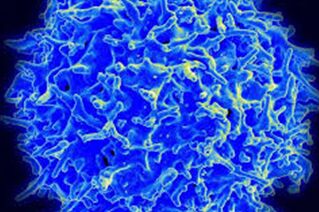科学家首次记录下HIV通过性传播的全过程
|
While it's well known that HIV is transmitted sexually, how the virus crosses genital mucus membranes to reach its targets in the immune system is less well understood. Previous research has looked at biochemical measurements or morphology at various points during HIV transmission to investigate this process, but in a study published in the journal Cell Reports, researchers in France constructed an in vitro model of urethral mucosa in order to view it from start to finish.
"We had this global idea of how HIV infects this tissue, but following something live is completely different. The precise sequence of events can be defined, and we were very surprised by them," says senior researcher Morgane Bomsel, a molecular biologist at the Institut Cochin. In the videos, a T cell infected with fluorescent-green-labeled HIV encounters epithelial cells of a reconstructed urethral mucosal tissue. When the infected T cell and an epithelial cell come into contact, a kind of pocket forms, called a virological synapse. This rearrangement of the infected cell's membrane spurs production of infectious HIV virus, which appears in the videos as green fluorescent dots. Then, like the neon green ray of a blaster gun in an old sci-fi movie, the virus sheds across the synapse into the mucosal epithelial cell. Importantly, the epithelial cell isn't infected: the virus simply travels across the cell via transcytosis. Once it crosses the epithelial layer, it's captured by immune cells called macrophages in the stroma. After an hour or two, once the virus has been produced and shed, the cell contact ends and the infected T cell moves on. These infected T cells are present in all genital fluids that vector infection. While cell-free viruses can cross the mucosa, they are much less efficient at penetrating it than cell-bound viruses that can make use of the virological synapse and transcytosis. These macrophages continue to produce and shed the virus for 20 days, after which they enter a latent, non-virus-producing state. But the virus is still stored in the macrophage. This poses a challenge for efforts to develop treatments for HIV, because the virus reaches these macrophage reservoirs in the genital tissue much earlier in the infection process than more frequently studied T cell reservoirs in the blood. "Once HIV is installed into a reservoir, it makes life very complicated if you want to eradicate the virus," Bomsel says. Treatment with antiretroviral therapies can keep reservoirs of the virus latent, but stopping the therapy allows the virus to rebound and continue spreading. "So an aim would be to act extremely early upon infection to avoid this reservoir formation, which is why I think a vaccine active at the mucosa is what you would need. Because you can't wait." This is something her team is already at work on. "We are trying to find ways to purge the reservoir, because we think we know how to kill the virus once we shock the reservoir. And another part of what we do here is work to develop a mucosal HIV vaccine," she says. "It's a complicated field, but I think it's important." |









